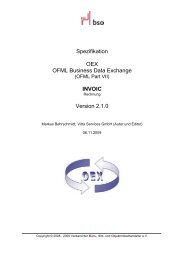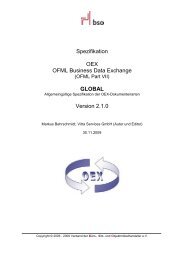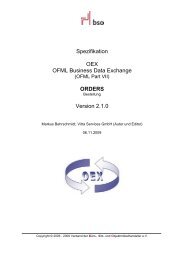22<strong>New</strong> <strong>Work</strong> orderIn addition to the need for a reasonable medium with which to communicate and share knowledgein a transparent way, there are other reasons for the introduction of social software. For example,insufficient flexibility as a result of lean management is one reason that motivated the introductionof a social platform at the automotive supplier Continental. To increase the competitiveness of theContinental group, personnel structures were streamlined and processes accelerated through leanmanagement. However, the cuts in management staff also led to a decrease in flexibility. At the beginningof the year, the social software “ConNext” began interconnecting departments and employeefunctions, creating more room to manoeuvre.Martina GirkensHead of Corporate FunctionsIT, Continental AGAfter studying computerscience and economics,Martina Girkensworked for severalIT manufacturers inthe fields of software,translation/marketingand outsourcing.From 1995 to 2007 sheworked for Siemens ITin Germany and Singapore.Since 2008 MartinaGirkens has beenCIO Corporate Functionsin the corporateIT department of ContinentalAG in Hanover.ContinentalNetwork MentalityAt the beginning of the year, the automotive parts supplier put the “ConNext” social networkonline with the aim of improving connectedness among the approximately 167,000employees. Trendbüro discussed the background and results of the project with MartinaGirkens, who oversaw the effort as Head of Corporate Functions IT at Continental AG.What motivated you to introduce a socialnetwork?Martina Girkens: As an automotive parts supplier,Continental operates in a very competitive environment.To stay competitive in this sector, Continental is continuallyoptimising efficiency through lean management.Over time, though, we’ve come to the realisation thatever leaner and faster processes leave less and lessroom for flexibility. Now our main interest is to dramaticallyincrease our flexibility to the previous level by gettingour employees better integrated into the companyand more involved.How does better integration of the staffimprove flexibility?We want to become more agile by letting our employeeshave a say, getting them involved in decision-makingand creating opportunities for feedback. I regard theproject as a sign of a cultural shift that’s being drivenby information technology. In the social network “Con-Next”, employees can indicate in their profiles whatthey can do and what they want. We’re hoping to encouragethe development of leaders in certain fields.What about interdepartmentalcollaboration?We’ve already seen quite a lot of that in our day-to-daywork. This approach implies that employees will establishcontacts and take part in activities outside the hierarchyand beyond the boundaries of their own teams.We aren’t enforcing any rules with regard to how employeesorganise their time if they don’t work in theirown department 100 percent of the time. We consider itnatural to get involved in things outside of your own department.And from now on we want to provide incentivesfor employees to share their knowledge in the networkand participate in the discussion. Of course, thispresupposes the appropriate understanding and behaviouron the part of the managers involved.Does the network replace conventionallyorganised work?We regard our networks at Continental as a supplementand rather like an electronic form of the officegrapevine. At the same time, we need the hierarchy inthe company, because it provides orientation and thesense of belonging to a team. Our networks create verypositive patterns of behaviour among our employees.Coworkers motivate one another and provide mutualsupport. That’s important for creating a feeling of connectednesswith the company at the global level. Employeesnow share knowledge more efficiently, becausethey can see what’s already known. It wasn’t possible toshare knowledge in this way before “ConNext”.How has communication changed as aresult?More than anything else, I see big changes in the wayinformation is acquired. The image of the boss handingout information is definitely obsolete; we’re movingfrom a “push” to a “pull” system of getting information.The information is no longer pushed to the employee;the employee can select what he or she considers important.But despite all the potential offered by “Con-Next”, the business cannot, should not, and will not berun entirely without any direct contact. After all, somethings are simply best discussed face to face.
23<strong>New</strong> <strong>Work</strong> orderPotential not yetexhausted72 % of the companiessurveyed by the McKinseyGlobal Institute usesocial technologies, butonly a few are able toenjoy anything liketheir full benefit.(McKinsey 2012b)IBM is likewise aiming for a more flexible form of organisation and more efficiency in human resourcescosts. To achieve these goals, the company is pursuing a very radical approach. In this casetoo, it is hoped that introducing social software will maintain the loyalty of their skilled workersand make it possible to deploy them in line with their capacities. IBM is planning to externalise alarge portion of its workforce (the newspaper Handelsblatt refers to 8,000 of the 20,000 employeesin Germany) and hire them for individual projects as needed. A virtual talent cloud will be setup to act as a human resources pool that combines internal, externalised and third-party specialists.Marketing personal abilities and receivingpositive feedback from reference projectsimproves Reputations in the talent cloudThis global human resources pool will be accessed according to an auction system. A core team remainingat the company will purchase the appropriate specialists for its project work through a biddingprocess. Straight-line employment histories and lifelong jobs are already becoming obsolete.Flexible knowledge workers, must therefore respond by continually optimising their professionalexpertise and profiles in order to enhance their appeal to employers across departmental and corporateboundaries. Technical infrastructure is the heart of the fluid organisations that are now commonlyseen at small and medium-sized companies and are now being set up at IBM. Only with thiskind of infrastructure is it possible to manage the relationships between core organisations and externalproject workers. But social networks help to connect people with one another efficiently inmore closed organisational structures as well. Internal company social networks already top the listof Web 2.0 tools that companies are planning to use in the future (bso 2012).Obsolete knowledge40% of the departmentheads at the large companiessurveyed reportthat the knowledge requiredfor their core activityis becoming obsoletefaster and faster.(Hays 2011)Hiring externalworkers20% of the companieswith project teamsstaffed solely with internalemployees areplanning to strengthenthese teams by addingexternal workers. (ibid.)Heterogeneous teamsAlmost 60% believethat mixed teams increasetheir productivityand capacity for innovationas a result ofthe knowledge transferbetween internal andexternal workers. (ibid.)WHICH TOOLS SHOULD BE USEDIN FUTURE (COMPLEMENTARILY)?Companies that already utiliseWeb 2.0 applicationsCompanies that have not yetutilized Web 2.0 applicationsWeb 2.0 used internallySocial networks aregaining groundForumsBlogsMicroblogsSocial networksActivity streamsCorporate wikis3.4%5.7%5.7%23.0%2.3%8.0%1.9%2.8%1.9%12.3%0.9%9.4%Companies that alreadyuse Web 2.0tools are more likelyto make increased useof such tools in the future.12.3% of the companiesthat do not yetuse any Web 2.0 applicationsintend to introducea social networkin the future.(bso 2012)Organisations have to change their structures, processes and culture.To enjoy all the benefits of social technologies, companies must begin to change their organisations,structures, processes and culture. They have to become more open, they have to have flat hierarchies,and they have to create a culture of trust. Ultimately, the effects of social technologies depend on the extentto which staff members unconditionally and enthusiastically participate in them and help shape them. Theyshould have no scruples about sharing their ideas, and they should expect that their contributions will beappreciated. So the actual challenge is not introducing the technology but creating the right conditions for it.Dr. Jacques Bughin, Director, McKinsey & Company, Brussels
















